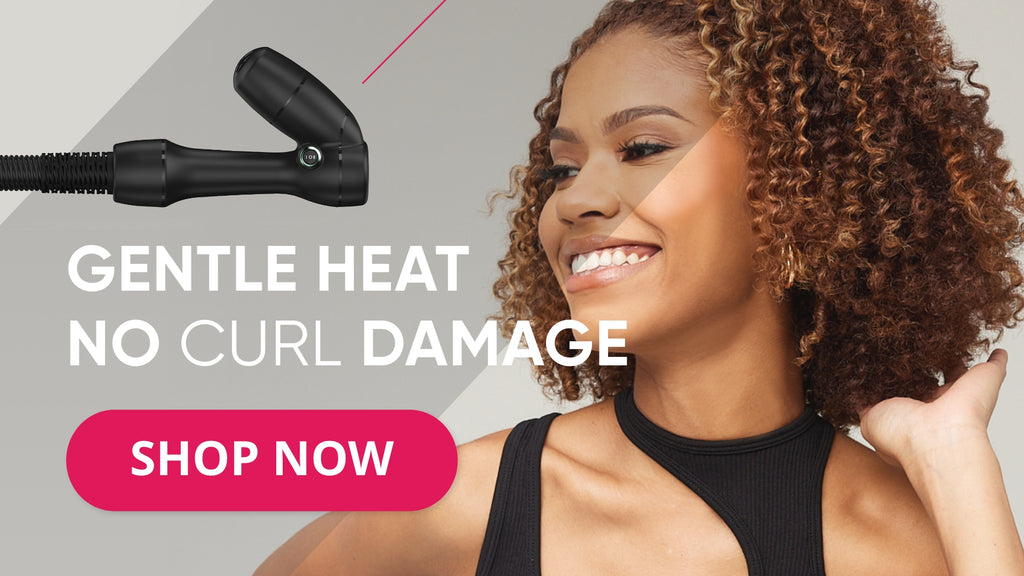
The Science Behind Drying Curly Hair: Understanding Your Curls and Heat Styling
Understanding the science behind heat styling, specifically drying, is essential to achieve the best results while maintaining the health and integrity of your curls. In this blog, we'll explore the intricacies of blow drying curly hair and the science that underpins it. We'll also discuss how the RevAir Reverse-Air hair dryer sets itself apart from other technologies and the unique benefits it offers to those with curly hair.
Understanding Your Curls:
Before delving into the science of blow drying, let's first understand the unique structure of curly and coily hair. Type 3 and 4 hair textures have distinct characteristics that require special care:

Hair Structure:
Curly hair is coiled, with a natural curl pattern that can range from loose waves to tight coils. This structure makes it more prone to dryness and frizz due to the limited distribution of natural oils along the hair shaft.
Porosity:
Curly hair is often more porous, meaning it can absorb and lose moisture easily. This can be influenced by the hair's cuticle structure and the use of hair products.
Tension and Elasticity:
Curly hair has less tensile strength and is more susceptible to breakage, making it important to handle it with care.
The Science of Drying Curly Hair:
Blow drying curly hair involves applying heat to manipulate the hair's structure and moisture content. The process can be complex, but understanding the science behind it can help you achieve your desired results without causing harm to your curls:

Heat and Moisture:
Curly hair needs moisture to maintain its elasticity and flexibility. Heat styling, especially with high temperatures, can strip hair of its natural moisture. This is where the science of hydration comes into play. It's crucial to maintain an optimal moisture balance in your hair before, during, and after blow drying.
Heat Damage:
Excessive heat exposure can lead to heat damage, which manifests as brittle, frizzy, and unmanageable curls. Understanding the threshold at which your hair can handle heat is vital. For many, lower heat settings are often more suitable to prevent damage.
Cuticle Control:
Curly hair tends to have raised cuticles, which can make it susceptible to frizz. Blow drying can help smooth these cuticles, but the process should be gentle to avoid damaging them (not damaging like blow drying with a brush’s pull).
The Role of the RevAir Reverse-Air Hair Dryer:
Now that we've established the importance of preserving the integrity of curly hair while heat styling, let's delve into the unique benefits of the RevAir Reverse-Air hair dryer:

Gentle Heat and Tension:
The RevAir dryer utilizes low heat and gentle tension to dry and straighten your hair. This is a game-changer for curly hair, as it minimizes the risk of heat damage and overexposure to high temperatures. The gentle tension helps smooth the cuticles without causing harm.
Reduced Drying Time:
Traditional blow dryers can take a long time to dry curly hair, which can be cumbersome and expose your curls to heat for extended periods. The RevAir dryer significantly reduces drying time, making the process more efficient.
Enhancing Natural Curl Patterns:
While the RevAir is often associated with straightening, it can also enhance your natural curl patterns by maintaining their integrity while reducing frizz and promoting healthy, bouncy curls.
The Impact of Other Heat Styling Tools:
While the RevAir Reverse-Air hair dryer offers unique advantages for curly hair, it's essential to acknowledge the potential pitfalls of other heat styling tools such as flat irons, silk presses, and blow dryer brushes. These tools can pose significant challenges for those with type 3 and 4 hair.

Flat irons, for instance, subject your hair to high temperatures that can lead to heat damage and a loss of your natural curl pattern. Silk presses, while providing a straightened look, also expose your curls to heat that can strip them of their moisture. Blow dryer brushes, while convenient, may cause excessive tension and heat exposure, leading to damage. Understanding these risks underscores the importance of choosing heat styling tools and techniques carefully, especially for those with curly and coily hair.
In the quest for maintaining healthy, beautiful type 3 and 4 curly hair, a firm grasp of the science behind heat styling and the right choice of tools is crucial. The RevAir reverse hair dryer, with its gentle heat and tension, reduced drying time, and the ability to enhance your natural curl patterns, stands out as a remarkable solution for those seeking the perfect balance between style and hair health.
By understanding your curls, the impact of heat, and the advantages of the RevAir dryer, you can enjoy the beauty of your curly locks without compromising their integrity. Remember, with knowledge and the right tools, you can confidently embrace your natural curls while experimenting with different styles, even in the harshest of weather conditions.















